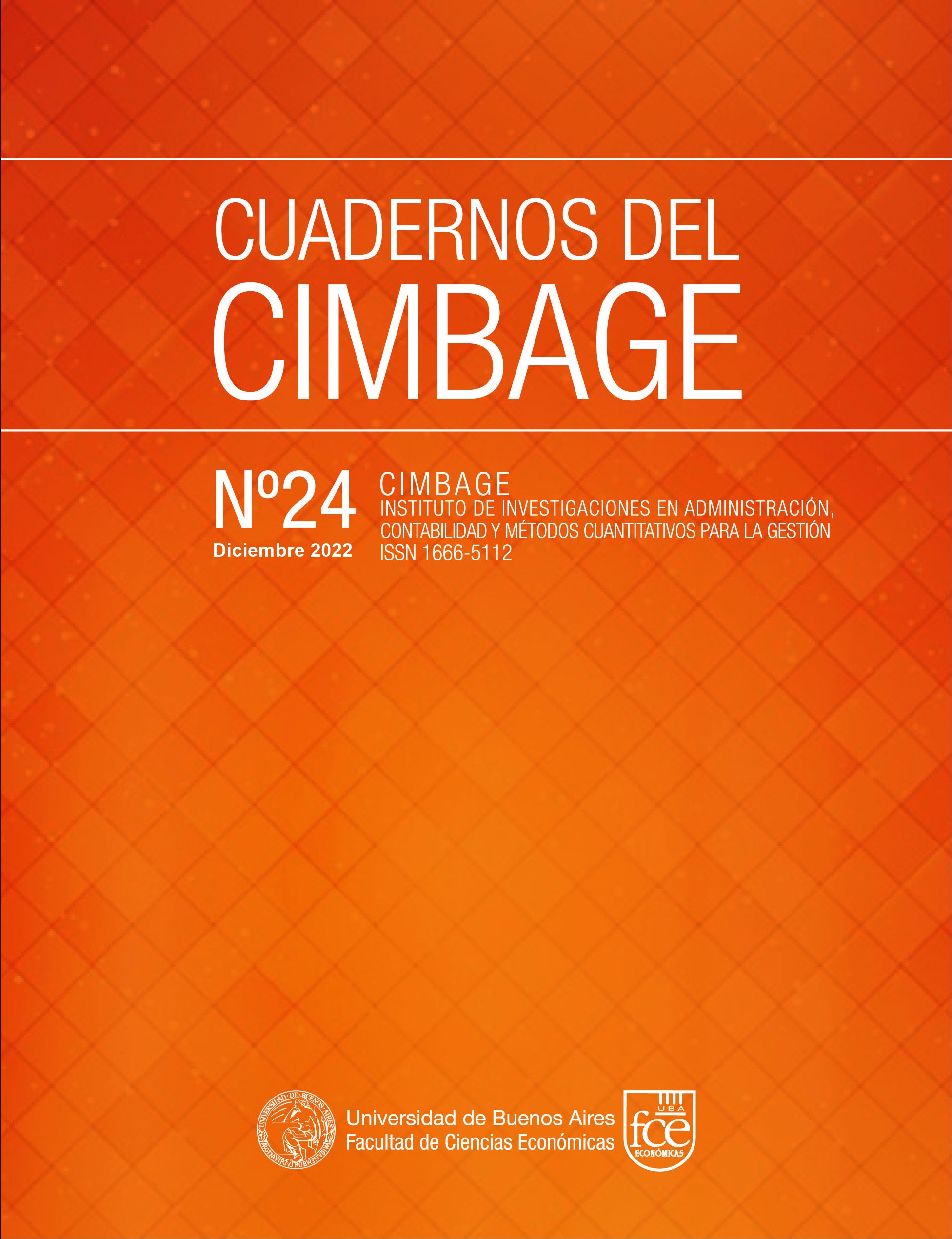La evolución del discurso sobre sostenibilidad. Un análisis lingüístico de afinidad
Resumen
La presente investigación tiene como objetivo principal explorar las relaciones entre los textos sobre sostenibilidad a través del tiempo, haciendo visibles los discursos, sus puntos de origen y el grado de afinidad existente entre las prácticas discursivas específicas sobre la sostenibilidad, mediante la agrupación de la literatura como son documentos y tratados en el marco de la sostenibilidad. El método utilizado para extraer los grupos más afines es el Algoritmo de Pichat y la distancia relativa de Hamming. Los resultados obtenidos muestran 10 grupos de documentos afines por temáticas sobre sostenibilidad, los cuales no necesariamente siguen un patrón consecutivo en el tiempo, su agrupación se inclina a los ejes centrales o perspectivas sobre la sostenibilidad.
Descargas
Citas
Alfaro-Calderón, G. G., y Alfaro-García, V. G. (2014). El algoritmo de Pichat en la selección de los integrantes de un Clúster. Repositorio de La Red Internacional de Investigadores En Competitividad, 8(1).
Alfaro Calderón, Gerardo Gabriel; Alfaro García, Víctor Gerardo; Hernández Silva, V. (2017). Teoría Fuzzy Logic Aplicada en la Integración de Cluster. 230–247.
Chaudhary, R. (2018). Green buying behavior in India: an empirical analysis. Journal of Global Responsibility, 9(2), 179–192.
Clark, R. A., Haytko, D. L., Hermans, C. M., y Simmers, C. S. (2019). Social Influence on Green Consumerism: Country and Gender Comparisons between China and the United States. Journal of International Consumer Marketing, 31(3), 177–190. https://doi.org/10.1080/08961530.2018.1527740
Coarasa, A., & Pequeño, D. (2006). El" Manifiesto por la vida": una perspectiva filosófica. Theomai, 0(13).
Paula, L. B., y Lafuente, A. M. G. (2018). Una contribución al desarrollo sostenible de las empresas a partir de lógica borrosa. Cuadernos Del CIMBAGE, 1(20), 51–83.
Foro Mundial Sobre Soberanía Alimentaria. (2001). Declaración final sobre soberanía alimentaria. La Habana, Cuba.
García-Orozco, D., Espitia-Moreno, I. C., Alfaro-García, V. G., y Merigó, J. M. (2020). Sustainability in Mexico a bibliometric analysis of the scientific research field presented in the last 28 years. Inquietud Empresarial, 20(2), 101–120.
García-Orozco, Dalia, Espitia-Moreno, I. C., Alfaro-García, V., y Merigó, J. M. (2020). Sustentabilidad en México un análisis bibliométrico de la investigación científica presentada en los últimos 28 años. Inquietud Empresarial, 20(2), 101–120.
Garza, E. G., y Gaudiano, É. G. (2010). De las teorías del desarrollo al desarrollo sustentable (1ra ed.). México: Siglo XXI y Universidad Autónoma de Nuevo León.
Genovese, A., Acquaye, A. A., Figueroa, A., y Koh, S. C. L. (2017). Sustainable supply chain management and the transition towards a circular economy: Evidence and some applications. Omega, 66, 344–357. https://linkinghub.elsevier.com/retrieve/pii/S0305048315001322
Gil-Aluja, J., Gil-Lafuente, A. M., y Merigó, J. M. (2011). Using homogeneous groupings in portfolio management. Expert Systems with Applications, 38(9), 10950–10958. https://doi.org/10.1016/j.eswa.2011.02.138
Giovannoni, E., y Fabietti, G. (2013). What Is Sustainability? A Review of the Concept and Its Applications. In Integrated Reporting (pp. 21–40). Cham: Springer International Publishing.
Gómez, C. (2006). El desarrollo sostenible: conceptos básicos, alcance y criterios para su evaluación. Cuestiones de Sociología (5-6), 295–312.
Kajikawa, Y. (2008). Research core and framework of sustainability science. Sustainability Science, 3(2), 215–239.
Kajikawa, Y., Tacoa, F., y Yamaguchi, K. (2014). Sustainability science: the changing landscape of sustainability research. Sustainability Science, 9(4), 431–438.
Kaufmann, A., y Gil-Aluja, J. (1993). Special techniques for the management of experts. Vigo: Milladoiro, D.L.
Larrondo, D., Bernal, E., y López, M. (2015). Marketing Sustentable. Donde la innovación crea valor. https://www.researchgate.net/publication/283317009 Consultado 19/10/2019
Meadows, D., Meadows, D., Randers, J., y Behrens, W. (1972). Los límites del crecimiento: Informe al Club de Roma sobre el predicamento de la humanidad. Fondo de Cultura Económica, No. HC59.(L42), 255.
Monge, R. G., Alfaro-García, V. G., Espitia-Moreno, I. C., García-Orozco, D., y de Vivar Mercadillo, M. R. R. (2022). Environmental Sustainability: A 10-Year Bibliometric Analysis of the Developments in Management, Business, Finance and Economics. https://doi.org/10.1007/978-3-030-96150-3_18
Norton, G. H., y Salagean, A. (2000). On the Hamming distance of linear codes over a finite chain ring. IEEE Transactions on Information Theory, 46(3), 1060–1067. https://doi.org/10.1109/18.841186
ONU. (2015). Objetivos de Desarrollo Sustentable 2015-2030. https://www.un.org/sustainabledevelopment/es/sustainable-consumption-production/ Consultado 23710/2019
Rothenberg, L., y Matthews, D. (2017). Consumer decision making when purchasing eco-friendly apparel. International Journal of Retail & Distribution Management, 45(4), 404–418.
Santillo, D. (2007). Reclaiming the Definition of Sustainability (7 pp). Environmental Science and Pollution Research - International, 14(1), 60–66.
Simon, D. (1987). Our Common Future: Report of the World Commission on Environment and Development. Third World Planning Review, 9(3), 285.
Yadav, R., & Pathak, G. S. (2016). Young consumers’ intention towards buying green products in a developing nation: Extending the theory of planned behavior. Journal of Cleaner Production, 135, 732–739.
Aquellos autores/as que tengan publicaciones con esta revista, aceptan los términos siguientes:
- Los autores/as conservarán sus derechos de autor y garantizarán a la revista el derecho de primera publicación de su obra, el cuál estará simultáneamente sujeto a la Licencia de reconocimiento de Creative Commons Atribución-NoComercial-CompartirIgual 4.0 Internacional (CC BY-NC-SA 4.0) que permite a terceros copiar y redistribuir el material en cualquier medio o formato y adaptar — remezclar, transformar y construir a partir del material bajo la la misma licencia del original. En todos los casos, debe dar crédito de manera adecuada.
- Los autores/as podrán adoptar otros acuerdos de licencia no exclusiva de distribución de la versión de la obra publicada (p. ej.: depositarla en un archivo telemático institucional o publicarla en un volumen monográfico) siempre que se indique la publicación inicial en esta revista.
- Se permite y recomienda a los autores/as difundir su obra a través de Internet (p. ej.: en archivos telemáticos institucionales o en su página web) antes y durante el proceso de envío, lo cual puede producir intercambios interesantes y aumentar las citas de la obra publicada. (Véase El efecto del acceso abierto).
 Esta obra está bajo una Licencia Creative Commons Atribución-NoComercial-CompartirIgual 4.0 Internacional.
Esta obra está bajo una Licencia Creative Commons Atribución-NoComercial-CompartirIgual 4.0 Internacional.


